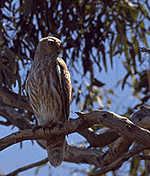Barking owl

Common name: barking owl
Scientific name: Ninox connivens
Family: Strigidae
Conservation status: This species is listed as Least concern in Queensland (Nature Conservation Act 1992).
Description: Barking owls have dark brown feathers, with white spots on the wings. Growing to 40cm, with large staring yellow eyes, they are an imposing bird.
Habitat and distribution
You're likely to see barking owls in Australia's north-east and north-west, and might also come across them in Victoria, South Australia and Western Australia.
Here they can be found in open dry eucalypt woodland, riparian scrubs (e.g. casuarina thicket) and Melaleuca woodland. They roost by day in leafy trees often near watercourses and forage late in the afternoon and into the night in open woodland/forest.
Life history and behaviour
Dogs aren't the only animals that bark at night. Just before dusk you might hear distinctive 'wook wooks', as barking owls start calling to each other.
Listen to the 'wook wook' of the barking owls.
They are capable of eating everything from small insects to fish, bats, cockatoos, ducks, rats and rabbits. Their diet depends largely upon prey availability. Like other owls, they can swivel their heads to look behind in search of prey.
Between July and November females can lay 2-3 eggs in vertical or steeply sloping hollows up to 20 m from the ground. Nests are built in trunks or large limbs of trees. The eggs are incubated for 38 days and the young fledge at 49 days. The barking owl will have one brood per season but may not breed every year.